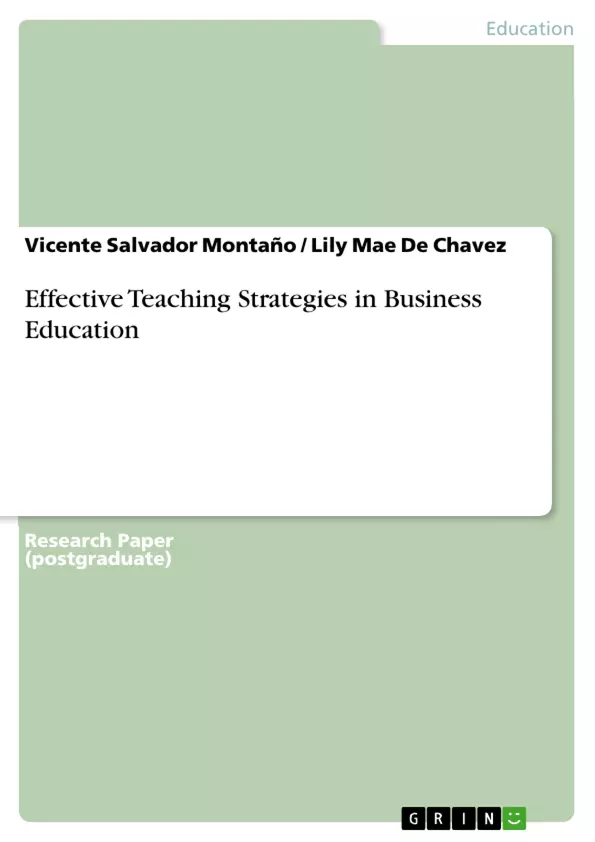Numerous studies dwell on investigating the best teaching strategies for students to learn. Few studies try to investigate teaching strategies that are effective in business education. However, fewer studies examine the preferred teaching strategy of business students.
This study explores the preferred teaching strategy of business students by using the conjoint analysis. The regression model suggested that a significant proportion of the total variation in the student’s ranking was predicted by quizzes (-1.47E-15), group work (1.0), project (1.3), recitation (-6.52E-16), lecture (1.0) and time management (0.33) [F(6, 20) = 11.67, p = 0.008]. The result implied that business students preferred the scaffold learning in a student-centered class. A blended learning must be used when teachers engaged students in lectures and reporting. In addition, a teacher’s poor time management of class affects learning.
Frequently asked questions
What is the content discussed in the preview?
The preview includes a table of contents listing sections such as Introduction, Framework, Objectives of the Study, Methodology, Statistical Treatment of Data, Results and Discussions, Conclusions, Recommendations, and Literatures Cited.
What is the introduction about?
The introduction discusses the need to raise educational achievement in the Philippines, the importance of preparing students for tertiary education, the role of the k-12 program, and the necessity of clear year-level competencies in higher education. It also touches upon the challenges faced by institutions with open admission policies.
What framework is the study based on?
The study is based on Lev Vygotsky's Scaffolding Theory, which focuses on the support teachers provide to students for deeper learning. It also mentions the zone of proximal development (ZPD).
What are the objectives of the study?
The study aims to determine which teaching strategies help students learn in their professional courses, identify strategies needing improvement, and determine the steps to improve the professional course.
What methodology was used?
The study uses purposive sampling with 134 students from business administration programs (HR, MM, FM). The bulk of respondents are third and fourth-year students. Self-constructed questionnaires were administered to gather data on experiences with different teaching strategies.
What statistical treatment of data was used?
The study used conjoint analysis to identify preferred teaching strategies among students taking professional courses. Students were asked to identify teaching strategies that helped them learn best and strategies needing improvement. Multiple regression analysis was also utilized.
What were the results and discussions about?
The results show student perceptions of different teaching strategies' effects on learning. It discusses the negative effect of quizzes, the benefits and drawbacks of group work (cooperative learning), the advantages and disadvantages of project-based learning (PBL), the role of class reporting, the significance of lectures and the impact of poor time management.
What are the main conclusions?
The study concludes that business students prefer group work, projects/research, and lectures as learning strategies. However, class reporting and poor time management are perceived negatively. A student-centered class is favored.
What are the recommendations?
It is recommended that faculty utilize project or research-based teaching strategies more often in a student-centered classroom, scaffolding learning effectively. Blended learning that combines lecture with other delivery methods should be utilized to create a classroom that meets all the diverse needs of the students.
What kind of information is provided in Table 1?
Table 1 displays the profile of the respondents, including their year level (first, second, third, fourth year) and program (HR, MM, FM), along with corresponding frequencies and percentages.
What is shown in Table 2?
Table 2 shows the teaching strategies that help and improve learning in the course. It includes aspects of the course that help to learn best (assignment, quizzes/exams, lectures, group work, projects/research, recitation/reporting) and advises to help improve learning in the course (more lectures, application, more group-work, more relevant examples, be hands on, others) alongside their corresponding frequencies (f) and percentages.
What does Table 3 contain?
Table 3 presents the preferred teaching strategies of business students based on multiple regression analysis. It includes variables like intercept, quizzes, group work, projects/researches, recitations/reporting, lecture, and time management, along with their respective unstandardized partial slope (B), standard error (Se()), t-values (t) and significance levels (Sig).
- Quote paper
- Vicente Salvador Montaño (Author), Lily Mae De Chavez (Author), 2015, Effective Teaching Strategies in Business Education, Munich, GRIN Verlag, https://www.grin.com/document/338218



